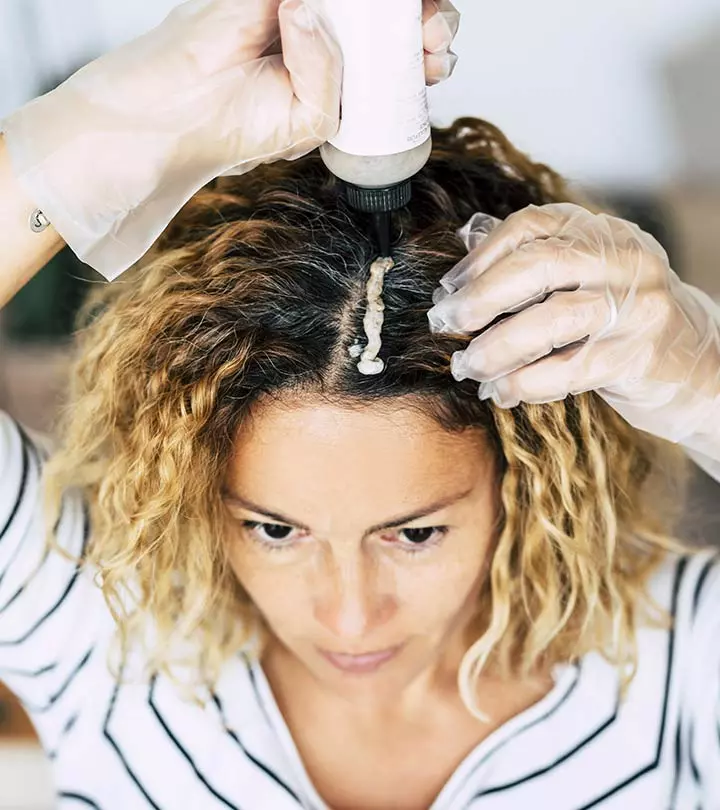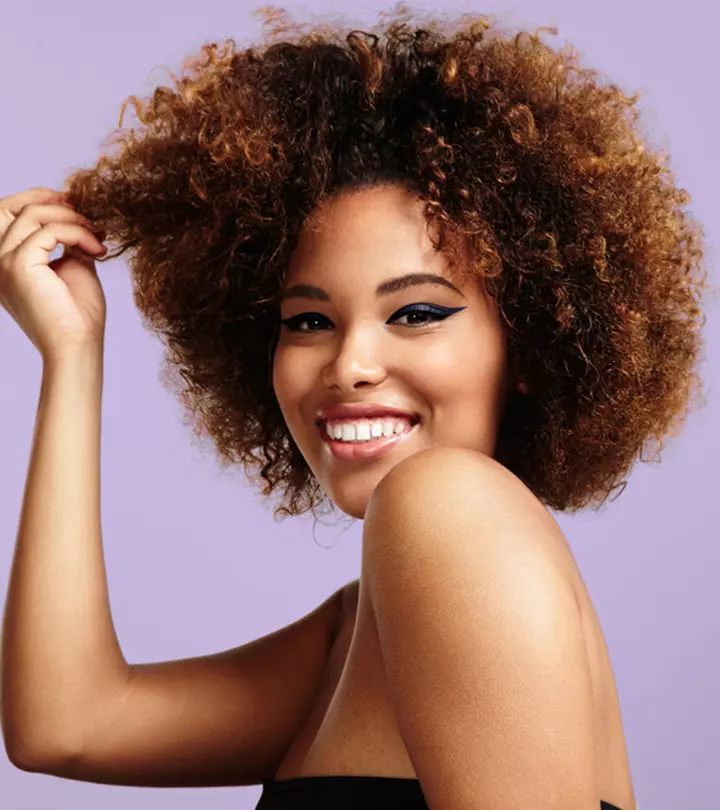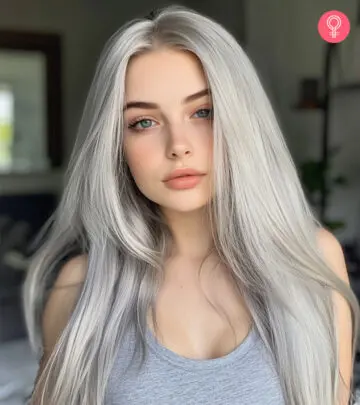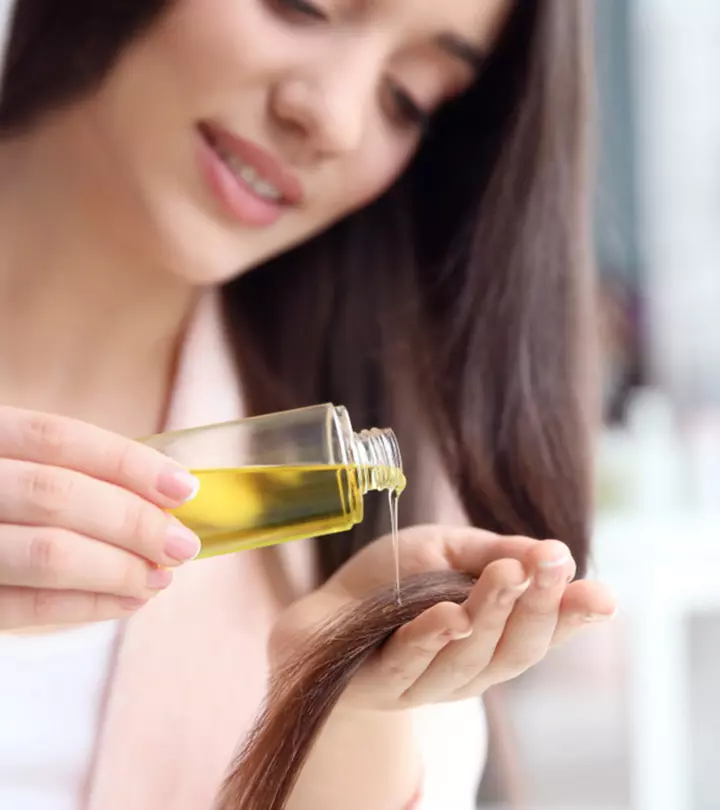How To Take Care Of Bleached Hair – Dos & Don’ts
Take care of your bleached hair the right way to maintain its optimal health.

Image: Shutterstock
Bleach is used to lighten darker hair shades. But it makes hair extremely damaged and lifeless. If you want to know how to look after your bleached hair, step into our office! Bleaching agents penetrate hair strands and remove their natural pigmentation. This leaves your hair vulnerable to breakage. Even if your bleached locks look incredible at first, your hair color eventually fades and leaves your hair with brassy hues.
To revive and restore bleached hair, you must first understand its needs and learn to maintain it properly. And we will help you with that. In this article, you will learn how to nourish your bleached hair, restore moisture, protect it from damage, and keep tresses ever-so stunning. Scroll down and understand what you need to salvage your bleached locks. Keep reading!
In This Article
What Happens When You Bleach Your Hair?
According to research conducted by the Cleveland Clinic, bleaching your hair can deprive your locks of their protective coating, making your hair weak and prone to damage (1).
Additionally, bleaching (as opposed to other hair treatments) causes the most hair damage (2):
- Raises the hair cuticles, leading to excessive loss of moisture.
- Damages the hair’s natural protein structure to remove the hair color.
- Results in dry, brittle, and frayed hair with split ends once the bleach washes out.
- Bleaching agent, which is chemically strong, causes significant damage as it is typically applied for a longer time to lighten the hair’s natural color.
- Post bleaching, the use of heat-styling products can contribute to more damage.
Clearly, bleached hair is more susceptible to becoming brittle, dry, and damaged. But, why exactly does bleaching damage your hair? And, does it last forever?
For bleach to be effective and strip your hair of its natural color, it needs to penetrate deep into your hair shaft. Since these chemicals are aggressive, your hair shaft is bound to become thinner and more damaged.
However, here’s the good news: The damage to your bleached hair will not last forever. With special care and time, you can rebuild your hair protection and get your healthy, shiny hair back.
Moreover, you can always go for a haircut if your ends are too damaged to be repaired. With a new crop of healthy hair growing from the roots, you can invest in an expert-approved hair care routine and start afresh, giving your tresses a fighting chance.
 Trivia
TriviaIf your core concern is how to keep your hair healthy after bleaching it, check out the useful do’s and don’ts in the next section.
Key Takeaways
- Bleaching may damage your hair, making it weak and prone to breakage.
- But you can reverse this damage with hair oils, masks, shower filters, and purple shampoo.
- Not tieing your hair tight and avoiding sun exposure and hot showers also helps prevent damage.
- Scalp massage with rosemary oil, onion juice extract, and witch hazel can repair damaged bleached hair.
Do’s And Don’ts Of Bleached Hair: How To Take Care Of Bleached Hair
7 Dos For Keeping Bleached Hair Healthy
- Invest In A Silk Pillowcase And A Microfiber Towel
Yes, silk pillowcases and microfiber towels are worth the hype!
They prevent any unnecessary pulling, breaking, or stretching of the hair, especially around the hairline. Their ultra-soft and absorbent materials maintain the natural texture of the hair without causing any further frizz or damage.
- Get A Shower Filter
Using a shower filter seems like an unusual suggestion, but it works.
Water often contains unwanted chemicals, grime, and minerals that cause brassiness, dehydration, and hair breakage. A shower filter can get rid of these substances from the water in a pinch.
- Be Patient If the Bleach Job Goes Awry
If you are not happy with the color of your bleached hair, wait for a couple of weeks before jumping right back to bleaching.
This helps your hair catch a break and recover. You can either alternate between full and partial highlights with a gap of 6-8 weeks in between or go for ammonia-free hair dye options to change the tone altogether.
- Apply Deep-Penetrating Hair Oils And A Quality Hair Care Mask

Your hair needs moisture and hydration after every bleaching session. So, massage it with deep-penetrating oils such as argan oil, coconut oil, or almond oil that can repair from within.
You can also go for a hair mask ritual to get healthy bleached blonde hair.
- Start by applying the mask to shampooed, damp hair.
- Use a wide-toothed comb to disperse it evenly.
- Put on a shower cap and wait for 20 minutes before rinsing it off.
Make sure to run the damp ends of your hair with 2-3 drops of oil before and after you wash your hair.
 Quick Tip
Quick Tip- Nourish Your Hair
It is important to hydrate hair after bleaching as the treatment has an extremely harsh and drying effect. So, when washing your bleached hair, switch to sulfate-free, protein-rich, moisturizing shampoos and conditioners.
Use protein-rich conditioners to nourish and maintain the integrity of your bleached hair.
You can also follow this with a leave-in treatment serum to add that extra boost of hair nourishment and hydration.
- Buy Multipurpose Hair Formulas
Numerous hair products add shine to your hair, detangle it, and act as a heat protectant. Speak to your hairstylist and get your hands on the ideal one.
- Use A Purple Shampoo

Use a purple shampoo to eliminate brassy tones and brighten your blonde hair. However, it is recommended that you wait 2 weeks after bleaching your hair before you start using one. Then, you can use it once between every few washes.
Additionally, apply the shampoo only to the roots if your ends look bright. If you have highlights, simply mix it with your regular shampoo. Do not use a purple shampoo if your hair seems severely dry and damaged.
6 Don’ts For Bleached Hair Aftercare
- Don’t Go Overboard With Bleaching
If you have dark hair, there are different levels of bleached hair that you can choose from based on how light you want your hair to be. You might require multiple bleaching sessions to get your desired color if you are going several levels light. However, bleaching your hair repeatedly within a short period of time can cause intense damage. Take special care of your hairline to see how long you should leave the color on each section of the hair. Also, allow your hair a few days of breathing time between sessions.
- Don’t Skip Haircuts And Avoid Dead Ends
Getting a trim to get rid of dry and damaged ends is one of the best ways to repair your hair. Since the hair at the ends is farthest from the roots, it is bound to get excessively dry and coarse, especially after a bleaching session. As a general rule, aim to get a hair trim within a week of the bleaching treatment. After this, you can visit the salon once every 8 weeks.
- Don’t Tie Your Hair Too Tight

This one’s a no-brainer. Tying up your hair too tight can lead to unnecessary hair breakage.
- Don’t Shower With Hot Water
We know that hot water showers feel heavenly. However, they are bad for your bleached hair. The high heat can strip your hair of its natural oils. If you can’t shower with cold water, consider showering with lukewarm water.
- Don’t Expose Your Hair To The Sun
We all know the sun’s harsh UV rays are harmful to your hair and can leave it weak, brittle, and dry and also lead to color fading. So, avoid excessive sun exposure as much as possible. Wear a hat or a scarf around your head when stepping out.
- Don’t Brush Your Hair When It Is Wet
The best way to keep your hair healthy after bleaching is to avoid combing it while it is still wet. Your hair is more fragile and prone to breakage when wet. This cardinal rule applies to all types of hair.
If you are wondering how to make your hair healthy again after bleaching, you can try a few home remedies to overturn the damage. Here are some hair damage prevention tips categorized by hair concerns to get you going.
Top Tips To Repair Severely Bleach-Damaged Hair
A. For Tackling Hair Fall
To kickstart the natural hair regrowth process, try these methods and tips:
- Scalp Massage

Boosting blood circulation helps stimulate hair growth. You can increase blood flow to the scalp by massaging it when you wash your hair (3). You can use your fingers or a shampoo brush to massage your scalp.
- Rosemary Oil
A study conducted on mice found that rosemary oil can promote hair growth (4). Here’s a handy DIY remedy that you can try:
- Use rosemary oil with any carrier oil (coconut, almond, sesame, etc.) in a 1:1 ratio.
- Massage it onto your scalp.
- Leave it on for a few hours or overnight before washing it off.
- Onion Juice Extract
There is some scientifically-backed evidence that onion juice aids hair regrowth in people affected by alopecia areatai An autoimmune disorder characterized by sudden hair loss that is often unpredictable and patchy. (5). Here’s how you can try this remedy to battle hair fall after applying bleach:
- Extract the onion juice by blending some 2 onions and straining out the pulp.
- Apply the onion juice to your scalp and leave it on for 15 minutes.
- Wash off the juice with shampoo.
Note
: Avoid this method if you have seborrheic dermatitisi A condition of the scalp and other oily areas of the body that causes dandruff, scaly patches, and skin inflammation. or dandruff, as onion juice may irritate the scalp.
B. For Taking Care Of Scalp Problems
Often times, you may hear people with bleached hair complaining about scalp issues such as irritation, redness, dryness, and flaking. If that is the case, your scalp needs some heavy-duty conditioning. Here are some natural ingredients that you can use to condition your hair:
- Witch Hazel
Witch hazel is power-packed with astringenti The property of a cosmetic substance that contracts the skin cells and other tissues, which helps tighten the skin. and anti-inflammatory properties that can offer some relief to a damaged scalp (6). You can buy an alcohol-free witch hazel formula or make your own with the following steps:
- Dilute witch hazel with equal parts water or a carrier oil like coconut or olive oil.
- Pour the ingredients into a spray bottle.
- Be sure to apply the witch hazel spray to your scalp and not your hair.
- Peppermint Oil

Thanks to its anti-inflammatory properties, peppermint oil can stimulate circulation, relieve itching, and treat a flaky scalp. An animal study suggests that a 3% concentration of this essential oil may even promote hair growth (7).
- Aloe Vera
Aloe vera is one of the best natural moisturizing and anti-inflammatory substances and can also treat an inflamed scalp (8). This soothing ingredient is known to heal hair and scalp damage when applied topically.
Note: Conduct a patch test for allergies before using any of these ingredients on your scalp.
C. For Addressing Brittle Hair
Contrary to popular opinion, hair breakage and home remedies are a match made in heaven. A little extra care after bleaching your hair can benefit you in the long run:
- Allow Your Hair To Air-Dry
As a thumb rule, don’t use a blow dryer or a terry cloth towel to dry your hair. Both these methods of drying your tresses can damage your hair cuticles. Even hair straighteners and curlers are a no-go. Simply let your hair air-dry naturally.
Éireann, a YouTuber, shared her journey to revive her bleach-damaged hair in her video. The first thing she did was stop bleaching her hair too often. She said, “Secondly, I stopped using any heat on my hair. I didn’t use any heat on my hair for over a year or two (i).” She mentions that she air-dried her hair and opted for heartless curls.
- Say Goodbye To Tight Hair Bands
Your hair does not need additional stress after bleaching. So, keep your hair down and loose to prevent putting extra stress on your hair roots.
Now that we’ve looked at some tips and treatments for getting healthy bleached hair, let’s answer some other pressing questions to help you keep your dye job beautiful.
How Often Should You Wash Bleached Hair?
We all know that shampooing your hair too often can strip away its natural oils. Considering that bleaching dries out your hair in the first place, avoid washing your hair more than three times a week (at the maximum).
You may even consider opting for the Olaplex treatment at home (ideally pick up a bottle of No. 3). There is anecdotal evidence of Olaplex preventing breakage and restoring the hair bonds that have been broken during bleaching.
However, the results may vary based on the extent of hair damage, so make sure to consult a hairstylist to be on the safe side.
Is Coconut Oil Good For Bleached Hair?
Organic, cold-pressed coconut oil is among the best hair styling products to keep bleached hair healthy. Every health and beauty brand stresses using this all-purpose, versatile oil on your tresses, and rightfully so.
According to a study conducted in India, coconut oil acts as a soothing agent both before and after you wash your hair. It prevents both damaged and undamaged hair from losing protein (9).
How Long Should You Wait To Wash Your Hair After Bleaching?
Wait for at least 48 to 72 hours before shampooing or hair conditioning after bleaching it. Doing so gives your hair time to seal in the new color. After that, alternate between moisture- and protein-rich shampoos and conditioners. Don’t go overboard with the use of either, and definitely don’t wait too long between washes as it can lead to dry, brittle ends.
You can trim your hair within seven days of coloring your hair to help seal the ends.
Infographic: Homemade DIY Hair Bleach
Bleaching may lead to hair damage and breakage. It can also make your hair look dull and lifeless. Therefore, many people prefer to use homemade DIY recipes to bleach their hair. They are prepared with natural ingredients and cause no damage to your beautiful tresses.
Check out the infographic below to learn how to prepare a homemade DIY hair bleach to lighten your hair without any damage. Illustration: StyleCraze Design Team
Bleaching your hair too much without caring for it leaves it looking damaged, dry, and lifeless, much like that old broomstick you just threw out. By following some simple hair care tips, you can bleach your hair without leaving it heavily damaged. In short, you need to look after your bleached hair to keep it looking healthy and stunning.
As with everything important in life, it takes time, patience, and effort to keep your hair healthy after you bleach it. This is because bleaching agents penetrate your hair strands to remove your hair pigments from within.
Thankfully, following a well-measure cocktail of hair care tips, maintaining a regular hair care regimen, and practicing good hair maintenance tips can resurrect your lifeless bleached hair.
Frequently Asked Questions
What are the most ideal types of shampoos for bleached hair?
The best shampoos for bleached hair are sulfate-free, moisturizing, and color-safe. Look for products containing ingredients like keratin, argan oil, or nourishing botanical extracts to maintain hydration and prevent damage.
Is vinegar good for bleached hair?
Yes. For a pick-me-up for bleached hair, look no further than vinegar! It can help enhance the color and revive lackluster locks to offer a refreshed look.
Is apple cider vinegar good for bleached hair?
Yes. Apple cider vinegar is a great solution for keeping bleached hair vibrant and shiny! It helps preserve color and enhance radiance, ensuring your dye stays fresh and beautiful.
Is lemon juice good for bleached hair?
No. Lemon juice is acidic and can make the bleached hair more dry, frizzy, and prone to breakage.
Illustration: How To Take Care Of Bleached Hair - Dos & Don&039ts

Image: Stable Diffusion/StyleCraze Design Team
Discover how to keep your color-treated or dyed hair healthy. Watch this video to learn about various tips to help maintain your hair’s vibrancy and shine.
Personal Experience: Source
StyleCraze's articles are interwoven with authentic personal narratives that provide depth and resonance to our content. Below are the sources of the personal accounts referenced in this article.
i. How I saved my extremely damaged bleached hair – staying blonde fried + dead to thick + healthyhttps://www.youtube.com/watch?v=fkZfmq8mbPE
References
Articles on StyleCraze are backed by verified information from peer-reviewed and academic research papers, reputed organizations, research institutions, and medical associations to ensure accuracy and relevance. Read our editorial policy to learn more.
- Hair Dye Safety: What You Need to Know About Salon and Box Color.
https://health.clevelandclinic.org/hair-dye-safety-what-you-need-to-know-about-salon-and-box-color - Significant damage of the skin and hair following hair bleaching.
https://pubmed.ncbi.nlm.nih.gov/20860738/ - Standardized Scalp Massage Results in Increased Hair Thickness by Inducing Stretching Forces to Dermal Papilla Cells in the Subcutaneous Tissue.
https://www.ncbi.nlm.nih.gov/pmc/articles/PMC4740347/ - Promotion of hair growth by Rosmarinus officinalis leaf extract.
https://pubmed.ncbi.nlm.nih.gov/22517595/ - Onion juice (Allium cepa L.), a new topical treatment for alopecia areata.
https://pubmed.ncbi.nlm.nih.gov/12126069/ - Antioxidant and potential anti-inflammatory activity of extracts and formulations of white tea, rose, and witch hazel on primary human dermal fibroblast cells.
https://www.ncbi.nlm.nih.gov/pmc/articles/PMC3214789/ - Peppermint Oil Promotes Hair Growth without Toxic Signs.
https://www.ncbi.nlm.nih.gov/pmc/articles/PMC4289931/ - A Double-Blind, Placebo-Controlled Trial of an Aloe Vera (A. Barbadensis) Emulsion in the Treatment of Seborrheic Dermatitis.
https://www.tandfonline.com/doi/abs/10.3109/09546639909055904 - Effect of mineral oil, sunflower oil, and coconut oil on prevention of hair damage.
https://pubmed.ncbi.nlm.nih.gov/12715094/
Read full bio of Dr. Shruti Chavan
Read full bio of Arshiya Syeda
Read full bio of Ramona Sinha
Read full bio of Medha Deb



























Community Experiences
Join the conversation and become a part of our empowering community! Share your stories, experiences, and insights to connect with other beauty, lifestyle, and health enthusiasts.